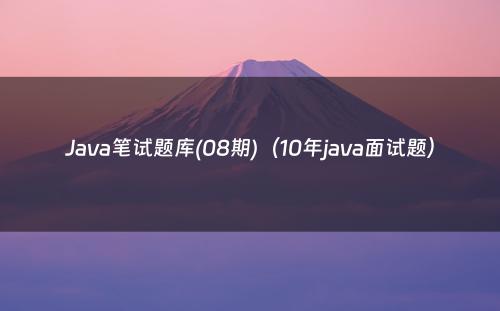网站首页 > java教程 正文
上期回顾:Java笔试题库(07期)

见如下代码:
public class IntTest {
public static void main(String[] args) {
Integer i1 = 100;
Integer i2 = 100;
Integer i3 = 150;
Integer i4 = 150;
System.out.println(i1 == i2);
System.out.println(i3 == i4);
}
}问题来了:输出的结果是什么?最好先有自己的答案再看分析,欢迎留言自己的见解!
问题分析:
1,首先要搞清楚==与equal的区别以及各自比较的是什么
==操作符专门用来比较两个变量的值是否相等,也就是用于比较变量所对应的内存中所存储的数值是否相同,要比较两个基本类型的数据或两个引用变量是否相等,只能用==操作符。
equals方法是用于比较两个独立对象的内容是否相同,就好比去比较两个人的长相是否相同,它比较的两个对象是独立的。
所以首先弄清楚了,对于上面代码中,我们是比较变量所对应的内存中所存储的数值是否相同。
2,要了解自动装箱和拆箱的概念
JVM会自动维护八种基本数据类型的常量池。
在上面代码中,第一次Integer i1 = 100;时会把i1写入常量池,当定义i2时,数据一样,不会再去创建新的对象,所以,第一个输出的是true。
但是这里Integer并不是八种基本数据类型啊,这里涉及了自动装箱和拆箱的概念。自动装箱就是Java自动将原始类型值转换成对应的对象,比如将int的变量转换成Integer对象,这个过程叫做装箱,反之将Integer对象转换成int类型值,这个过程叫做拆箱。
因为这里的装箱和拆箱是自动进行的非人为转换,所以就称作为自动装箱和拆箱。原始类型byte,short,char,int,long,float,double和boolean对应的封装类为Byte,Short,Character,Integer,Long,Float,Double,Boolean。
3,int在常量池中的初始化范围
int常量池中初始化-128~127的范围,所以当为Integer i1,i2=100时,在自动装箱过程中是取自常量池中的数值,而当Integer i3,i4=150时,150不在常量池范围内,所以在自动装箱过程中需new 一个150,所以上面代码第二个输出的是false。
下面贴出int常量池的部分代码供大家参考:
/**
* Cache to support the object identity semantics of autoboxing for values between * -
128 and 127 (inclusive) as required by JLS. *
* The cache is initialized on first usage.
The size of the cache * may be controlled by
the {@code -XX:AutoBoxCacheMax=<size>} option.
* During VM initialization, java.lang.Integer.IntegerCache.high property
* may be set and saved in the private system properties in the
* sun.misc.VM class. */
private static class IntegerCache {
static final int low = -128;
static final int high;
static final Integer cache[]; static {
// high value may be configured by property
int h = 127;
String integerCacheHighPropValue = sun.misc.VM.getSavedProperty("java.lang.Integer.IntegerCache.high");
if (integerCacheHighPropValue != null) {
try {
int i = parseInt(integerCacheHighPropValue);
i = Math.max(i, 127);
// Maximum array size is Integer.MAX_VALUE
h = Math.min(i, Integer.MAX_VALUE - (-low) -1);
}
catch( NumberFormatException nfe) {
// If the property cannot be parsed into an int, ignore it.
}
}
high = h;
cache = new Integer[(high - low) + 1];
int j = low;
for(int k = 0;
k < cache.length; k++) cache[k] = new Integer(j++);
// range [-128, 127] must be interned (JLS7 5.1.7) assert IntegerCache.high >= 127;
}
private IntegerCache() {}
}正确答案:
true
false
下面哪个流类属于面向字符的输入流( )
A BufferedWriter
B FileInputStream
C ObjectInputStream
D InputStreamReader
正确答案:D
以InputStream(输入)/OutputStream(输出)为后缀的是字节流。
以Reader(输入)/Writer(输出)为后缀的是字符流。
给大家一张很nice的图片:
(来自百度图库)
猜你喜欢
- 2024-10-12 常忽略的java面试笔试题目(java常见的面试题)
- 2024-10-12 Java笔试题库(06期)(牛客网java在线笔试题库)
- 2024-10-12 Java笔试题库(03期)(精选30道java笔试题解答)
- 2024-10-12 纯干货分享!2020阿里java岗笔试面试题总结(附答案)
- 2024-10-12 经典 SQL 数据库笔试题及答案整理
- 2024-10-12 Java基础笔试练习(七)(java基础试题)
- 2024-10-12 Java面试都会涉及到哪些内容?Java笔试题库(一)
- 2024-10-12 Java面试笔试题答案数据库/Spring框架/JVM/数据结构算法
- 2024-10-12 Java必考题目之JVM面试题目和答案
- 2024-10-12 腾讯 程序员 Java 笔试题目(腾讯笔试编程题)
欢迎 你 发表评论:
- 12-27惠普无线打印机连接手机教程
- 12-27win7原版系统在哪里下载(win7 原版下载)
- 12-26镜像下载软件(镜像下载软件哪个好)
- 12-26win732位安装包(windows7下载32位)
- 12-26excel表格电脑版下载(excel表格电脑版免费下载)
- 12-267723游戏盒子(7723游戏盒子免费安装)
- 12-26xp清除开机密码(xp清楚密码)
- 12-26macos各个版本发布日期(macos 发布)
- 最近发表
- 标签列表
-
- java反编译工具 (77)
- java反射 (57)
- java接口 (61)
- java随机数 (63)
- java7下载 (59)
- java数据结构 (61)
- java 三目运算符 (65)
- java对象转map (63)
- Java继承 (69)
- java字符串替换 (60)
- 快速排序java (59)
- java并发编程 (58)
- java api文档 (60)
- centos安装java (57)
- java调用webservice接口 (61)
- java深拷贝 (61)
- 工厂模式java (59)
- java代理模式 (59)
- java.lang (57)
- java连接mysql数据库 (67)
- java重载 (68)
- java 循环语句 (66)
- java反序列化 (58)
- java时间函数 (60)
- java是值传递还是引用传递 (62)

本文暂时没有评论,来添加一个吧(●'◡'●)